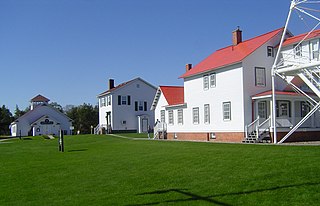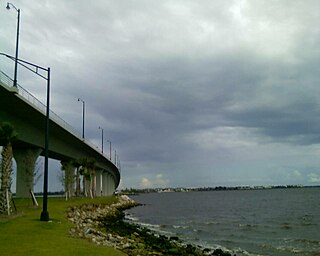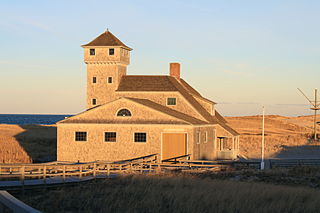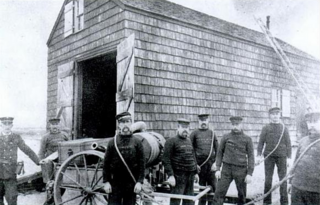
Martin County is a county located in the Treasure Coast region of the state of Florida, in the United States. As of the 2020 census, the population was 158,431. Its county seat is Stuart. Martin County is in the Port St. Lucie, FL Metropolitan Statistical Area.

St. Lucie County is a county in the U.S. state of Florida. As of the 2010 census, the population was 277,789. The county's seat is Fort Pierce. As of the 2019 Census Estimate, St. Lucie County has a population of 328,297. St. Lucie County is included in the Port St. Lucie, FL Metropolitan Statistical Area.

Stuart is a city in and the seat of Martin County, Florida, United States. Located on Florida's Treasure Coast, Stuart is the largest of four incorporated municipalities in Martin County. The estimated population is 16,237 according to the most recent United States census estimates. Stuart is the 126th largest city in Florida based on official 2019 estimates from the US Census Bureau. It is part of the Port St. Lucie, Florida Metropolitan Statistical Area.

The Great Lakes Shipwreck Museum is located at the Whitefish Point Light Station 11 miles (18 km) north of Paradise in Chippewa County in the U.S. state of Michigan. The light station property was transferred to the Great Lakes Shipwreck Historical Society (GLSHS), the Michigan Audubon Society (MAS), and the United States Fish and Wildlife Service (USFWS) in 1996. The three entities share governance of the site. The museum is operated by the GLSHS. The museum exhibits artifacts from shipwrecks from the Whitefish Point Underwater Preserve and the bell from the wreck of the SS Edmund Fitzgerald. Admission to the museum includes a tour of historic buildings with displays that interpret the Great Lakes maritime, United States Coast Guard, and US Life-Saving Service history.

The Hereford Inlet Light is a historic lighthouse located in North Wildwood in Cape May County, New Jersey, United States, situated on the southwestern shore of Hereford Inlet at the north end of Five Mile Beach. Its construction was completed and it became operational in 1874.

Execution Rocks Light is a lighthouse in the middle of Long Island Sound on the border between New Rochelle and Sands Point, New York. It stands 55 feet (17 m) tall, with a white light flashing every 10 seconds. The granite tower is painted white with a brown band around the middle. It has an attached stone keeper's house which has not been inhabited since the light was automated in 1979.

The United States Life-Saving Service was a United States government agency that grew out of private and local humanitarian efforts to save the lives of shipwrecked mariners and passengers. It began in 1848 and ultimately merged with the Revenue Cutter Service to form the United States Coast Guard in 1915.

Grand Marais is an unincorporated community and census-designated place (CDP) in Alger County in the U.S. state of Michigan. It is located within Burt Township on the shores of Lake Superior, and the community is the eastern gateway to the Pictured Rocks National Lakeshore via H-58.

The Two Harbors Light is the oldest operating lighthouse in the US state of Minnesota. Overlooking Lake Superior's Agate Bay, the lighthouse is located in Two Harbors, Minnesota. The construction of the lighthouse began in 1891 and was completed the following year, with the light being lit for the first time on April 14, 1892. The first Two Harbors keeper was Charles Lederle and there were normally three keepers assigned to make sure the light was lit every day. The Lighthouse was built to provide safe passage into the Agate Bay Harbor during the early 20th century, as Two Harbors was a major shipping point for the iron ore of the Mesabi Range.

The Houses of Refuge in Florida were a series of stations operated by the United States Life Saving Service along the coast of Florida to rescue and shelter ship-wrecked sailors. Five houses were constructed on the east coast in 1876, with five more added in 1885 and 1886. There were also two life-saving stations built, one just south of the Jupiter Inlet, the other on the Gulf coast on Santa Rosa Island near Pensacola, Florida. A house of refuge was planned for the Marquesas Keys, but was never put into commission. The houses were manned by civilian contractors who lived in the houses with their families. Most of these houses remained in service as life-saving stations until 1915 or later. Some of the locations became United States Coast Guard stations after the Life-Saving Service was merged with the United States Revenue Cutter Service to form the Coast Guard in 1915.

The Virginia Beach Surf & Rescue Museum honors and preserves the history of Virginia's maritime heritage, coastal communities, the United States Lifesaving Service, and the United States Coast Guard along the Atlantic coast.

The Plum Island Range Lights are a pair of range lights located on Plum Island in Door County, Wisconsin. They were part of the Plum Island United States Life-Saving Station. Plum Island was transferred to the United States Fish and Wildlife Service in 2007 and became part of the Green Bay National Wildlife Refuge. The life-saving station was listed on the National Register of Historic Places in 2010. Plum Island is closed to the public to protect ground nesting migratory birds.

The Krueger House is a historic house in Stuart, Martin County, Florida. It is located on the grounds of the historic Burn Brae Plantation. On February 14, 2002, it was added to the U.S. National Register of Historic Places.

The Georges Valentine Shipwreck Site is the site of the historic shipwreck of an Italian barkentine off the coast of Hutchinson Island in Martin County, Florida, with the nearest landmark being the House of Refuge at Gilbert's Bar.

Known for beautiful beaches, nature preserves and parks, Hutchinson Island consists of two barrier islands on the coast of Martin, St. Lucie, and Indian River counties, Florida. The two islands are separated by the Fort Pierce Inlet and are known as North Hutchinson Island and South Hutchinson Island. North Hutchinson Island is divided into two counties - Indian River County and St. Lucie County. The Indian River county portion of North Hutchinson Island which extends to the Sebastian Inlet is sometimes called Orchid Island, although it is not a separate island.

North Hutchinson Island is a coastal barrier island in Indian River and St. Lucie counties on the east coast of Florida in the United States. The island is adjacent to the Atlantic Ocean and is separated from the mainland on the west by the Indian River Lagoon. The portion of the island in Indian River County is known as Orchid Island.

Joshua James was an American sea captain and a U.S. Life–Saving Station keeper. He was a famous and celebrated commander of civilian life-saving crews in the 19th century, credited with saving over 500 lives from the age of about 15 when he first associated himself with the Massachusetts Humane Society until his death at the age of 75 while on duty with the United States Life–Saving Service. During his lifetime he was honored with the highest medals of the Humane Society and the United States. His father, mother, brothers, wife, and son were also lifesavers in their own right.

The Old Harbor U.S. Life Saving Station is a historic maritime rescue station and museum, located at Race Point Beach in Provincetown, Massachusetts. Built in 1897, it was originally located at Nauset Beach near the entrance to Chatham Harbor in Chatham, Massachusetts. It was used by the United States Life-Saving Service (USLSS), and then by its successor, the United States Coast Guard (USCG), as the Old Harbor Coast Guard Station. The station was decommissioned in 1944, abandoned and sold as surplus in 1947, and was used as a private residence for the next twenty-six years.

Coast Guard Station Toms River is a former United States Coast Guard station in Seaside Park, New Jersey at the mouth of the Toms River. The area was manned in 1856 with Samuel Chadwick as the first lifeguard. The first boathouse was constructed in 1872 by the New Jersey Life Saving Service as the Toms River Life Saving Station. Station Toms River was United States Life-Saving Service Station #13 and Coast Guard's Station #109 in the 5th District.

The Dune Shacks of Peaked Hill Bars Historic District includes dune shacks that were home to American artists and writers from the 1920s to present day. The historic district, located in the Outer Cape towns of Provincetown and Truro, comprises 1,950 acres of the Cape Cod National Seashore. It was listed on the National Register of Historic Places in 2012. The name is derived from a Life-Saving Station known as Peaked Hill Bars that was established in 1882 on the lower cape.


























